
Cotoneaster: planting, pruning, care
Contents
Cotoneaster in a nutshell
- Cotoneaster is an evergreen bush, undemanding and very hardy
- Very decorative thanks to its small evergreen fruits and flamboyant foliage late in the season
- It produces white or pink flowering in spring
- It grows in any well-drained soil and in all exposures
- It adds colour to hedges, borders and groundcover
A word from our expert
Cotoneaster is a small ornamental bush easy to grow producing a profusion of flowers in spring, and above all red or orange berries scattered through its very decorative foliage in autumn or on the naked branches in winter. Its exceptional adaptability and versatility make Cotoneaster an indispensable bush in all gardens without a gardener or with a naturalistic spirit.
Deciduous or evergreen Cotoneaster, prostrate or erect, pruned in neatly clipped hedges, bushy and alive with birds in wild hedgerows, groundcover cotoneaster to dress embankments and rockeries, whether they are Cotoneaster horizontalis or Cotoneaster franchetii, they all bring colour to every corner of the garden.
It can also be grown in large tubs on a terrace or a large balcony to create very dense, evergreen privacy screens. This undemanding bush adapts to all aspects, all climates and all soils provided they are well drained. Its cultivation is straightforward.
There is a cotoneaster for every use — discover our collection of cotoneasters, including some uncommon varieties.
Description and botany
Botanical data
- Latin name Cotoneaster
- Family Rosaceae
- Common name Cotoneaster
- Flowering May to July
- Height 0.15 to 5 m
- Exposure Sun, partial shade
- Soil type All, well drained
- Hardiness -15°C to -25°C
The Genus Cotoneaster comprises around 200 species, ranging from shrubs to groundcover species, most often with evergreen foliage (Cotoneaster lacteus and Cotoneaster franchetii), deciduous for some species (Cotoneaster horizontalis) or semi-evergreen (Cotoneaster suecicus). Only a few species are commonly grown in gardens. Passionate nurserymen may also offer rarer cottonasters such as the small prostrate Cotoneaster adpressus or Cotoneaster lucidus.
All belong to family Rosaceae and originate from wooded or rocky areas of northern Europe, Asia and northern Africa.
Cotoneaster is a upright or entirely prostrate bush, depending on species. Erect and spreading, with arching shoots for Cotoneaster franchetii, bushier and more horizontal with branches arranged in a herringbone pattern for Cotoneaster horizontalis, for Cotoneaster microphylla or completely prostrate in Cotoneaster dammeri. Shoots are more or less ramified according to species and cultivars. Wood of Cotoneaster apiculatus gives off a delicious cherry scent when cut.
Growth is moderate to fast even in poor soil and height varies from 15 cm to 4 m depending on whether plant is creeping, medium or large (2 to 5 m in all directions). Pruning and habit will determine its use.
Smaller forms such as Cotoneaster horizontalis or microphylla are much prized by bonsai enthusiasts.

Cotoneaster franchetii – botanical illustration
All display a handsome spread with considerable ground cover, sometimes up to 4–5 m or more as some creeping species naturally layer, readily colonising banks or hard-to-reach areas. Some have naturalised in many countries such as Australia and California where they are now considered invasive.
Cotoneaster forms attractive, dense bushy clumps valued for their evergreen to semi-evergreen foliage depending on climate, or deciduous. Thick, leathery leaves from 0.5 mm to 12 cm long, alternate, entire, ovate or elliptical, are medium to dark glossy or matt green above and often greyish green with a felted underside. Cotoneaster adpressus bears undulate leaves. Some cultivars such as Cotoneaster horizontalis Variegatus show cream-variegated green foliage.
Leaves emerge light green and darken with time, and turn yellow, deep purple-red or orange-red in autumn on some forms before falling. Deciduous types display more vivid autumn colour.
Flowering appears on this dense vegetation in late spring, from May to July depending on climate. Bush becomes dusted with numerous small simple 5-petalled flowers, usually white or sometimes pink, solitary or grouped in small clusters. Flowers are fragrant and highly melliferous, attracting pollinators. This bush is valued for supporting garden wildlife.
In September–October, this flowering gives way to highly decorative fruiting which enhances the plant’s charm. Clusters of small fleshy, round or ovoid fruits 1 to 10 mm long, red, vermilion, orange or dark purplish-black in Cotoneaster lucidus speckle the foliage. “Coral Beauty” bears bright coral-orange berries, Cotoneaster franchetii carries salmon berries, and some less common cultivars produce yellow drupes.
This abundance of glossy fruit often persists on shoots through much of winter, delighting birds and bringing colour to the garden in cold season.
Fruits are not edible and are toxic if eaten in large quantities.
Cotoneaster is a very accommodating bush that adapts to all aspects, all climates and all soils.
It is a robust and hardy to -25 °C and can be grown in all regions. It tolerates very harsh winters and occasional drought once established. It will prosper in sun or partial shade in any moderately fertile, well-drained soil, even stony.
Cotoneaster is an essential bush in a garden, whether gardener is absent or of a naturalistic mind. It is perfect in a mixed, bocage-style, country or clipped hedge. Evergreen, erect species quickly form a green screen to hide an intrusive view. Creeping cotoneaster makes an excellent groundcover.
It can also be trained against a wall or grown as bonsai. Some small forms can be grown in containers on a terrace and will provide a cascade of foliage.

Cotoneaster trained as bonsai
Species and main varieties
There are nearly 200 species of Cotoneasters distributed between bush species and groundcover species. Choice is wide for all gardens! All are undemanding, hardy and easy to grow, producing a profusion of flowers, colourful decorative berries or foliage that turns spectacular in autumn.
Only a few species are widely grown in our gardens: Cotoneaster franchetii, Cotoneaster dammeri, Cotoneaster horizontalis and Cotoneaster lacteus, which come in interesting cultivars and hybrids differing in their height at ripeness, their habit and their deciduous or evergreen foliage.
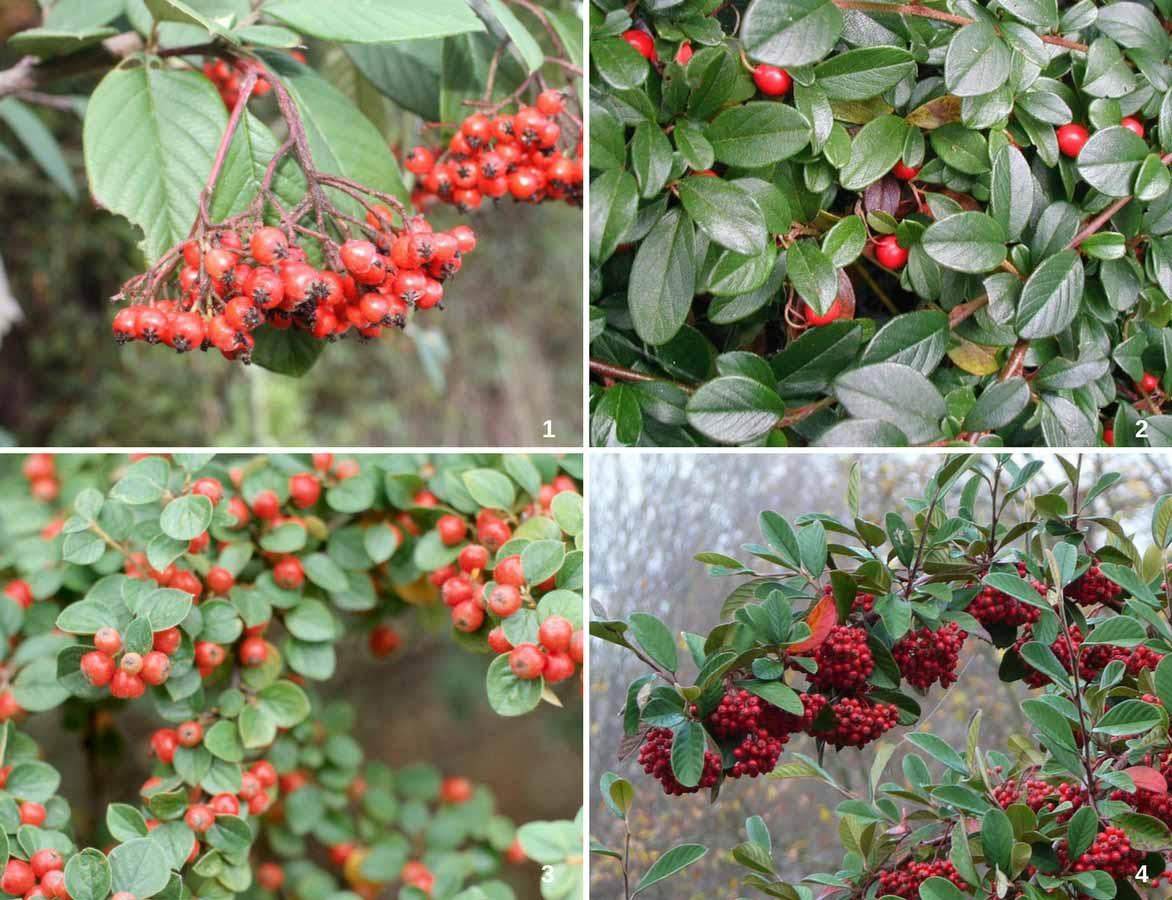
Main species grown in gardens: 1 Cotoneaster franchetii, 2 dammeri, 3 horizontalis and 4 lacteus
Depending on species, their habit ranges from upright to slightly trailing or entirely prostrate. Their height can vary from a few tens of centimetres to 4–5 m.
Prefer Cotoneaster franchetii and Cotoneaster lacteus to form a hedge 2 to 3 m high, Cotoneaster horizontalis is a giant creeping species ideal for a low hedge along a wall, Cotoneaster dammeri makes an excellent groundcover.
Alongside these common species, we offer a range of rarer cotoneasters well worth having, such as Cotoneaster adpressus, a small deciduous species with prostrate habit that forms a remarkably dense groundcover, and Cotoneaster lucidus, which allows rapid creation of a full hedge that will take on beautiful yellow to reddish-purple tones in autumn.
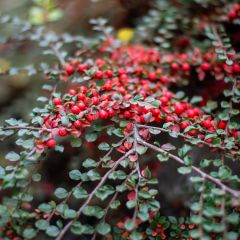
Cotoneaster horizontalis
- Flowering time June
- Height at maturity 1,20 m

Cotoneaster franchetii
- Flowering time June, July
- Height at maturity 3 m
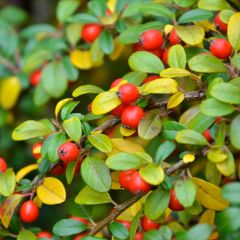
Cotoneaster dammeri Eichholz
- Flowering time June, July
- Height at maturity 35 cm

Cotoneaster microphyllus
- Flowering time June, July
- Height at maturity 80 cm

Cotoneaster lacteus - Milky Cotoneaster
- Flowering time June, July
- Height at maturity 3 m
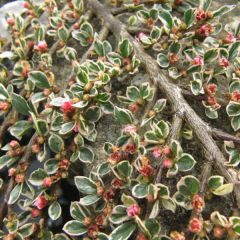
Cotoneaster horizontalis Variegatus
- Flowering time June
- Height at maturity 45 cm
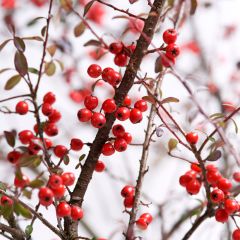
Cotoneaster suecicus Coral Beauty
- Flowering time July, August
- Height at maturity 60 cm
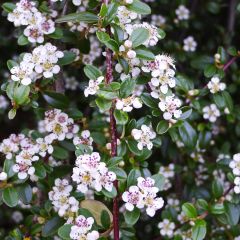
Cotoneaster procumbens Queen of Carpets
- Flowering time June, July
- Height at maturity 50 cm
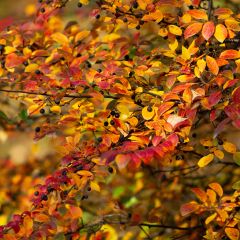
Cotoneaster lucidus
- Flowering time June, July
- Height at maturity 2 m

Cotoneaster adpressus Little Gem
- Flowering time June
- Height at maturity 25 cm
Discover other Cotoneaster
View all →Available in 3 sizes
Available in 3 sizes
Available in 2 sizes
Available in 1 sizes
Available in 1 sizes
Available in 2 sizes
Available in 3 sizes
Available in 2 sizes
Available in 1 sizes
Available in 1 sizes
Planting
Where to plant Cotoneaster?
Cotoneaster is a low-maintenance bush that will grow in almost any conditions and needs very little. Hardy down to -25°C, it can be grown in all regions, even those with very harsh winters. It also tolerates occasional droughts very well once established. Only large evergreen species need protection from cold, drying winds in areas where temperatures can remain below -10°C for long periods.
Although it tolerates dappled shade and will do well even in a shady corner of the garden, for optimal flowering and fruiting, plant Cotoneaster in a preferably sunny position. It grows in all soil types, even calcareous or stony soils. It simply needs well-drained soil as it dislikes waterlogged clay in winter.
Cotoneaster lends itself to all uses; its size and habit determine how it is used. It suits all garden styles.
In a brand-new garden, it quickly forms a screen or cushion of greenery.
Evergreen or deciduous, creeping cotoneasters (Cotoneaster microphylla, Cotoneaster dammeri) and medium-sized types make excellent groundcover and will green up slopes and difficult areas. Their ability to layer naturally makes them an excellent solution for stabilising banks. They are also perfect at the base of a large hedge or in a rockery. Their very dense growth limits appearance of weeds.
Upright forms, of large size (Cotoneaster lacteus, Cotoneaster franchetii) are suitable for free-standing or clipped hedges. These cotoneasters are ideal for creating an evergreen hedge, brightening a slightly shaded corner of the garden or for quickly forming a visual screen from neighbours.
Some, with a pendulous habit, make very attractive specimen bushes when trained as standards; they will then need a sufficiently large space. With its flexible branches, the Cotoneaster horizontalis can be easily trained against a wall.
Dwarf forms (Cotoneaster procumbens ‘Queen of Carpets’) will find their place in a pot on a terrace to define spaces, for example, or can be trained as bonsai. They can be combined with dwarf conifers or other small shrubs such as creeping juniper, Euonymus or Forsythia.
When to plant Cotoneaster?
Cotoneaster is best planted in autumn, from September to November to encourage rooting. Spring planting in March–April is possible for all specimens bought in containers. In all cases, plant after severe frosts.
How to plant Cotoneaster?
Cotoneaster is not very demanding, so planting is very simple. It needs good drainage; roots dislike stagnant moisture, with about twenty centimetres of free-draining material at the bottom of the planting hole.
In open ground
- Soak rootball if it is too dry
- Dig a hole at least three times the volume of the rootball
- Add pumice or gravel if necessary to improve drainage
- Plant and bring soil up around rootball without burying branches
- Firm down with foot
- Spread organic mulch to keep root area cool in summer
- Water well at planting then regularly during first summer
Planting density
A single plant may be enough to create a pleasing effect, especially for taller varieties and if mixed with other bushes, however, cotoneasters are spectacular planted in groups of 3 of the same variety.
For hedges, leave about 80 cm to 1 m between plants.
Lower, stoloniferous varieties are perfect for covering a bank where they will spread over the years. For a well-filled bank all winter, favour evergreen species and group planting (allow 3–5 plants per m²).
In a pot
Container planting is typical, in a roughly 30-litre pot filled with a mix of potting compost, garden soil and river sand, with a good layer of clay pebbles for perfect drainage. Water regularly, without excess.
Read also
Cotoneaster: which to choose?Pruning and care of Cotoneaster
Cotoneaster is an easy bush that requires no special care.
It only needs water in periods of very hot weather, and especially during dry spells in the year following planting to encourage good rooting. Once well rooted, it proves drought-tolerant. A few summer waterings will suffice even in prolonged drought. Potted cotoneaster has increased water needs: water as soon as surface soil is dry.
Most cotoneasters do not require regular pruning but benefit from being cut back from time to time. They tolerate pruning well and can even be cut hard back in early spring if necessary.
They only need a balancing prune to keep a compact habit, encourage generous flowering and fruiting, maintain dense foliage and promote new shoots on the trunk if it becomes bare. They can easily be trained as small standard trees by cutting lower branches. Some creeping species have a natural tendency to layer and colonise any space without limit. It is therefore better to monitor their spreading.
- Deciduous cotoneaster requires only minimal pruning to maintain a balanced silhouette. In February–March, after leaf fall and before growth resumes, simply cut back damaged shoot tips and remove wayward or tangled stems. Also eliminate dead wood.
- Evergreen cotoneaster needs only formative pruning during the first two years, in early spring or after flowering to balance the bush. Remove the longer shoots.
Trim cotoneaster hedges lightly in late summer, cutting stems back as close to the fruits as possible without removing them.
The shoots of espaliered specimens are pruned each year after flowering or at the end of winter to no more than 4 buds from the shoot base.
→ Read Ingrid’s tutorial: How to train a Cotoneaster?

Cotoneaster horizontalis trained against a wall
Potential diseases and pests
Cotoneaster is a bush hardy, fairly disease-resistant. However, like all plants in the rose family, its main enemy is fire blight, which dries out the bush within a few weeks and for which there is no cure. If attacked, prevent spread of the bacterium by removing affected parts and burning the stump. Root rot is also a disease risk, especially in very waterlogged soils.
It can also suffer in spring and summer occasional attacks from aphids and scale insects, which you can eliminate with a few sprays of soapy water. Less often, it may be attacked by defoliating caterpillars, which are more difficult to control.
→ Learn more about the diseases and parasitic organisms of Cotoneaster in our advice sheet.
Multiplication
Cotoneaster multiplies easily by propagation by cuttings, layering or sowing, the first method being the quickest and simplest.
Propagation by cuttings
Semi-hardwood cuttings are taken in September on evergreen Cotoneasters (make use of pruning period). In May–June, take herbaceous cuttings from deciduous species.
- Take cuttings from shoot tips 10–15 cm long, preferably with a heel at the base
- Make a 5 cm-long longitudinal cut in the bark
- Remove lower leaves and keep only two pairs of upper leaves
- Plant them about 7 cm deep in a well-draining mix of sand and potting compost
- Keep substrate moist until rooted under a cold frame
- Pot up cuttings, then plant out in ground in autumn or in following spring
- Water well during first year after planting
→ Find out more about propagation of Cotoneaster in our tutorial: propagation of Cotoneaster!
Companion plants for Cotoneaster
Excellent bush with evergreen or deciduous foliage, the Cotoneaster forms splendid informal hedges, clipped hedges or privacy screens and effective groundcovers that require little maintenance and mark the seasons with their changing colours. The pale pinkish-white early summer flowers, the glossy colourful fruits in autumn and winter, and the beautiful hues the foliage takes on in autumn make Cotoneaster essential in every garden. Versatile, this bush adapts to all uses in a naturalistic or wild garden and pairs easily with perennial plants or other deciduous or evergreen bushes, which will set off the leaf colours.
In a sunny position, it is easy to associate with Deutzia, mock orange, botanical roses, Kerria japonica, spiraeas, potentillas and perennial plants such as columbines, geraniums or foxgloves. Intertwining its foliage with a climbing plant such as a clematis or a dwarf honeysuckle will brighten it in summer.
It will stand out against a backdrop of plants with contrasting forms such as Japanese maples, euonymus, Nandina, holly with berries, or barberries. Bamboos and miscanthus will form a handsome evergreen background for Cotoneaster’s vividly coloured fruits while a Cornus alba ‘Baton Rouge’ will echo the colour of its berries on the naked branches. It does wonders in a loose hedge, paired with viburnums, lilacs or serviceberries, for example.
In autumn, Cotoneaster’s fruit-laden branches and the amber leaves of an Aronia will offer a spectacular pairing.
In a large evergreen hedge, planted en masse along an avenue, it pairs with many other easy-care bushes such as laurustinus, Pyracantha, strawberry trees, bay laurel, viburnums, Elaeagnus ebbingei and Photinia.
Cotoneaster horizontalis ‘Variegatus’ can be paired with bushes with variegated foliage such as Aucubas, Cornus alternifolia ‘Argentea’ and Rhamnus alaternus Argenteovariegata.
As groundcover under large deciduous trees, it will provide evergreen patches throughout winter when trees have lost their leaves. On banks, creeping Cotoneaster can be associated with creeping dogwoods, creeping juniper ‘Blue Star’, Euonymus ‘Emerald Gaiety’, Berberis thunbergii Atropurpurea ‘Nana’ and Forsythia intermedia ‘Marée d’Or’, a Ceanothus ‘Thyrsiflorus Repens’.

Idea for dressing a bank, attractive all year round: Cotoneaster horizontalis variegatus, Juniperus squamata ‘Blue Star’, Cornus sericea ‘Kelseyi’ and Berberis thunbergii atropurpurea ‘Nana’
It can also be grown in large containers on a patio or large balcony, combined with dwarf conifers or other small bushes to create evergreen privacy screens.
Useful resources
- Discover all our Cotoneasters, including some rare varieties
- Article: Cotoneaster: which to choose?
- Article: 5 Cotoneasters perfect for hedging
- Article: Cotoneaster: the best varieties to plant on a slope
- Subscribe!
- Contents
































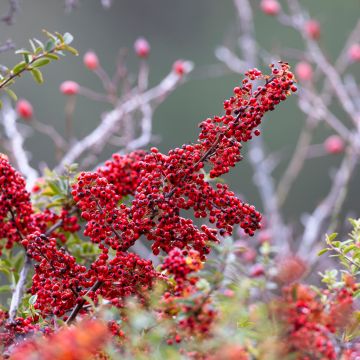

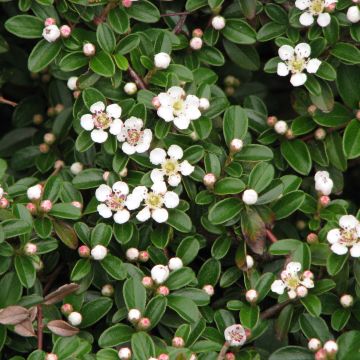
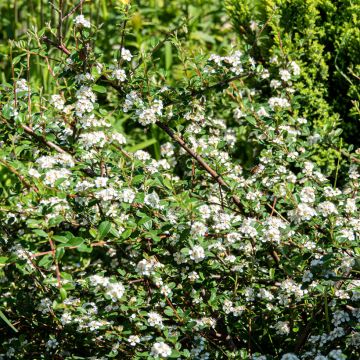

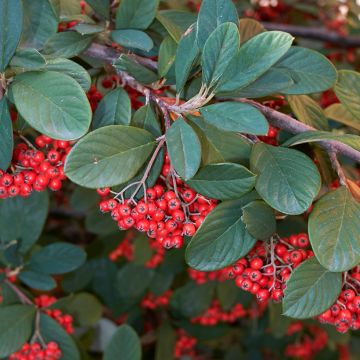


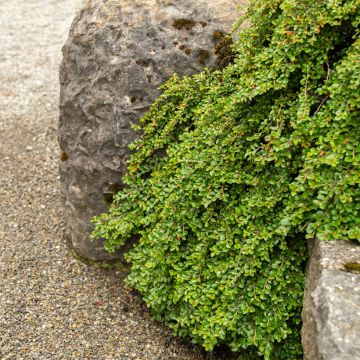
Comments